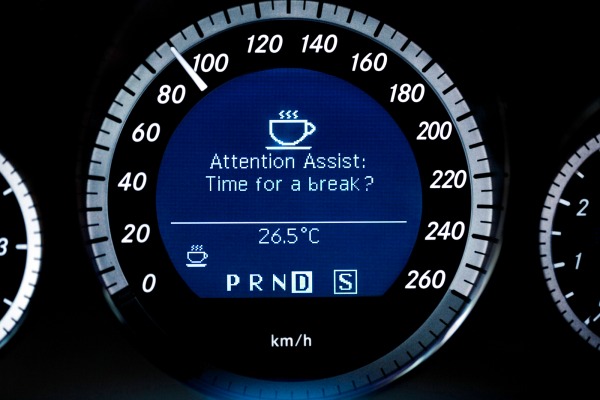
Drowsy driving can be as dangerous as drunken driving, and Americans are becoming increasingly aware of that.
In a 2011 survey by the AAA Foundation for Traffic Safety, 96 percent of those polled said it's unacceptable for someone to drive when they're so sleepy they have trouble keeping their eyes open. Yet, in the same poll, about one third of respondents said they had done just that in the past month.
Drowsy driving causes more than 100,000 crashes every year, according to the National Highway Traffic Safety Administration, and are implicated in 40,000 injuries and 1,550 deaths annually. Now, automakers are hoping that crash-avoidance technology, which is offered in growing numbers of vehicles, will help reduce the toll linked to drowsy drivers.
Technology won't replace common-sense measures like getting a good night's sleep, but it may put a dent in the accidents and fatalities.
Crash-Avoidance Technology To Combat Drowsiness
The term "crash-avoidance technology" covers a lot of features, including adaptive headlights (which improve night vision around corners and curves), forward collision warning, emergency brake assistance, lane departure warning and blind spot detection.
Of these features, forward warning technology and lane departure technology could possibly help drowsy drivers, says David Zuby, chief research officer for the Insurance Institute for Highway Safety (IIHS).
Forward collision-warning systems use sensors such as cameras, radar or a technology called light detection and ranging (LIDAR) to detect vehicles in front of the vehicle. Some systems also have automatic braking.
Lane departure warning systems use cameras to track the vehicle's position within the lane, alerting the driver if the vehicle strays across line markings.
Tracking the Trend
The use of crash-avoidance technology debuted in the U.S in 2007, notably by Volvo. Lexus, Mercedes and others jumped on the trend early. Ford recently announced it will include such technologies as Driver Alert, Lane Keeping Alert and Lane Keeping Aid in its 2013 Explorer.
For the 2012 model year, the National Highway Traffic Safety Administration (NHTSA) has identified 68 vehicle models that have either lane departure warning, forward collision warning or both. That's up from 45 vehicle models in the 2011 model year.
Those who are bullish on the technology predict it will become much more common.
"There will be a special lane for vehicles that can identify themselves as having this suite of technology," says Paul Williamsen, national manager of Lexus College, which trains employees for sales and product information.
Meanwhile, Adam Kopstein of Volvo predicts insurance companies may someday offer discounts to owners who opt for crash-avoidance features.
Specs and Costs
The costs for adding crash-avoidance technology to combat drowsy driving vary. Mercedes Benz's Attention Assist system is available at no extra cost for the 2012 model year in the C-Class, CL-Class, CLS-Class, E-Class, M-Class, S-Class, SLK-Class and SLS AMG. Eventually, all models will have it, says Mercedes spokesperson Nicole Weiss.
On the 2012 Volvo S60, S80, XC60 and XC70, the technology package that offers lane departure warning, driver alert control, collision warning with auto brake and other features adds $2,100 to the price of a car.
Here's a description of how two of the stay-alert systems work:
Crash Avoidance: How Effective?
Such stay-alert systems are so new that independent evaluations are sparse. "We are still in the process of trying to evaluate whether or not these technologies that have been put out in the field are helping drivers," the IIHS's Zuby says. "The jury is still out."
Nevertheless, there are conclusions for a related collision-avoidance feature called City Safety, which is available in the Volvo XC60 (a midsize crossover utility vehicle) and is meant to prevent low-speed crashes in traffic. IIHS found fewer insurance claims for low-speed crashes for this Volvo SUV than for other vehicles in its class. This Volvo video demonstrates the City Safety system.
The City Safety technology isn't the same as the forward collision warning systems, however. IIHS is studying forward-crash warning systems, lane-departure warning technologies and others, Zuby says.
The IIHS will have more research to release on crash-avoidance technology by the spring of 2012, institute spokesperson Russ Rader says. Meanwhile, the IIHS has estimated the potential value of the technology. If all passenger vehicles had full packages of these technologies, including forward collision warning, lane departure warning, adaptive headlights and blind-spot warning, one in three fatal crashes and one of five injury accidents probably could be avoided or their severity lessened, IIHS says.
Car shoppers interested in reviewing the technology offerings can use NHTSA's site for some guidance. For the 2012 model year, the agency lists information about the 68 vehicle models that have the crash-avoidance features, and whether a feature is standard or optional.
However, the agency doesn't recommend specific systems, says Jose Alberto Ucles, a NHTSA spokesperson. In the future, the agency may rate them, he says. Until independent evaluations are in, shoppers can heed tips of those who work in the industry, however partial they might be to their own systems.
What To .